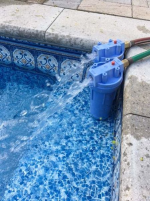I have a new pool about to be plastered. Current estimate is about 56k gallons. Water trucks aren't cheap around here. I don't want to pay 5kish in water if I can help it.
I have a larger than average well-pump on it. Great pressure. I can run 5 sprinkler heads on my irrigation and easily take a shower at the same time etc. etc.
Just wanted to ask a few questions to make sure my idea here isn't a bad one.
My well water Chemistry:
Hydrogen Sulfide NO
AKA I think my aquaphor has some pretty great water. The only thing that worries me is the .3 ppm of iron.
I had another test done and there weren't any other heavy metals that seems to be an issue.
I'm thinking that iron is just enough that I should try some mitigation or might have to manage the ferrous content over time after the fact.
If you're with me still thanks!
So questions:
1. I was considering buying Pentak Big Blue Filter housing as suggested on here and running the water through a 0.5 micron filter. It seems that would help with some of the ferrous iron although some people state that's smoke and mirrors and nothing mechicanical will work.
I figured it couldn't hurt... but if you think just getting a cheaper filter I might go that route. The Pentak should have a better flow rate though I'm thinking?
I also saw someone put two Big Blue's in series and go from 10 to .5... could do that too... to grab some sediment in first filter first. I'm thinking thats overkill. I have a whole house 5ppm filter and I don't see that much sediment in there after months use.
2. Fill rate - is that a concern? 56K gallons is a bunch to fill from a hose. I'm thinking I want to run at least 2 hoses at once. Even still it might take a few days to fill up. Is that an issue with the plaster? Do I need to worry about it taking that long to fill? I've read you most certainly do NOT interrupt the filling process but I haven't found any information on it having to be done in 30 hours or less or something.
3. I also read that I don't want anything touching the plaster. Normally hose is wrapped in a cloth etc. That won't really work if I have water shooting out of the Big Blue as pictured here elsewhere on the forum (and below). Perhaps I try to fasten the Big Blue to the drain or something so it isn't sitting on plaster? Or maybe put a base in somehow before using it and then just shoot the water on the base as a water truck would do?
Any help appreciated!

I have a larger than average well-pump on it. Great pressure. I can run 5 sprinkler heads on my irrigation and easily take a shower at the same time etc. etc.
Just wanted to ask a few questions to make sure my idea here isn't a bad one.
My well water Chemistry:
| Item | Your Results | EPA Guidelines for Safe Water |
| TDS | 103 | PPM 500 PPM or Less |
| pH | 7.2 | between 6.5 to 8.5 |
| Hardness | 40 PPM | Over 100 PPM is considered hard water |
| Iron | .3 PPM | .3 PPM or Less |
| Nitrate | 0 PPM | 10 PPM or Less |
| Nitrite | 0 PPM | Less than 1.0 PPM |
AKA I think my aquaphor has some pretty great water. The only thing that worries me is the .3 ppm of iron.
I had another test done and there weren't any other heavy metals that seems to be an issue.
I'm thinking that iron is just enough that I should try some mitigation or might have to manage the ferrous content over time after the fact.
If you're with me still thanks!
So questions:
1. I was considering buying Pentak Big Blue Filter housing as suggested on here and running the water through a 0.5 micron filter. It seems that would help with some of the ferrous iron although some people state that's smoke and mirrors and nothing mechicanical will work.
I figured it couldn't hurt... but if you think just getting a cheaper filter I might go that route. The Pentak should have a better flow rate though I'm thinking?
I also saw someone put two Big Blue's in series and go from 10 to .5... could do that too... to grab some sediment in first filter first. I'm thinking thats overkill. I have a whole house 5ppm filter and I don't see that much sediment in there after months use.
2. Fill rate - is that a concern? 56K gallons is a bunch to fill from a hose. I'm thinking I want to run at least 2 hoses at once. Even still it might take a few days to fill up. Is that an issue with the plaster? Do I need to worry about it taking that long to fill? I've read you most certainly do NOT interrupt the filling process but I haven't found any information on it having to be done in 30 hours or less or something.
3. I also read that I don't want anything touching the plaster. Normally hose is wrapped in a cloth etc. That won't really work if I have water shooting out of the Big Blue as pictured here elsewhere on the forum (and below). Perhaps I try to fasten the Big Blue to the drain or something so it isn't sitting on plaster? Or maybe put a base in somehow before using it and then just shoot the water on the base as a water truck would do?
Any help appreciated!


